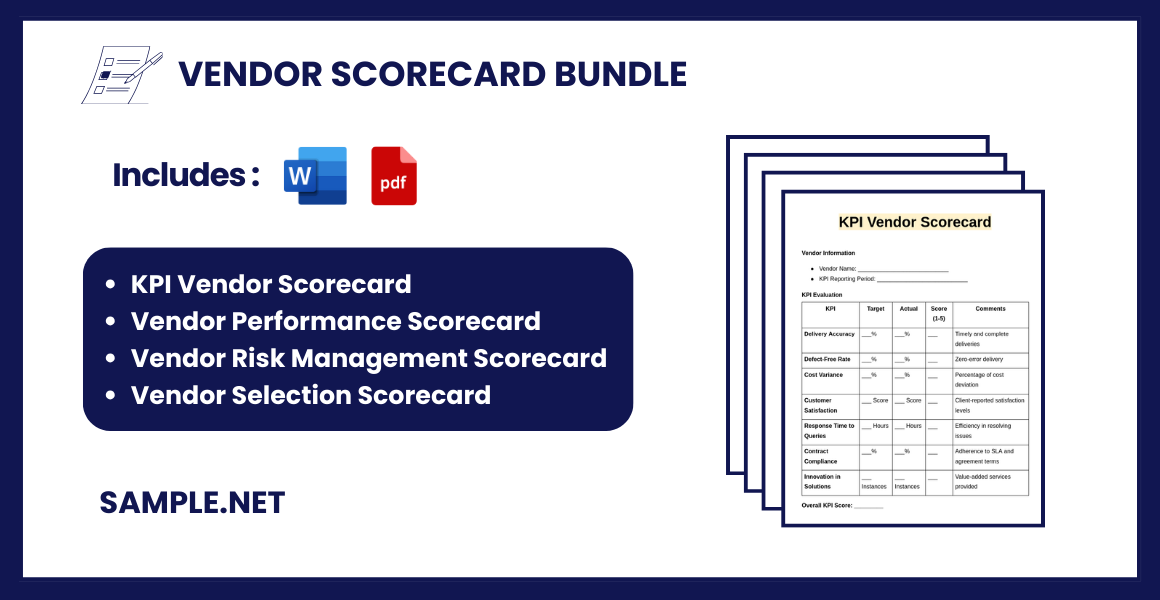
Download Vendor Scorecard Bundle
Vendor Scorecard Format
1. Vendor Information
- Vendor Name: ____________________________
- Contact Person: ____________________________
- Contact Information: ____________________________
- Product/Service Provided: ____________________________
2. Scoring Criteria
| Category | Weight (%) | Score (1-5) | Weighted Score | Comments |
|---|---|---|---|---|
| Quality | ___% | ___ | ___ | E.g., defect rates, consistency |
| Price/Cost | ___% | ___ | ___ | Competitive pricing, discounts |
| Delivery | ___% | ___ | ___ | On-time delivery performance |
| Responsiveness | ___% | ___ | ___ | Communication, problem-solving |
| Compliance | ___% | ___ | ___ | Adherence to regulations |
| Innovation | ___% | ___ | ___ | Suggestions for improvement |
| Customer Support | ___% | ___ | ___ | Post-sale support and service |
Total Weighted Score: _________
3. Scoring Guide
| Score | Description |
|---|---|
| 5 | Excellent |
| 4 | Good |
| 3 | Average |
| 2 | Below Average |
| 1 | Poor |
4. Overall Rating
- Rating: (e.g., Excellent, Good, Average, Below Average, Poor)
- Comments/Feedback:
- Strengths:
- Areas for Improvement:
- Strengths:
5. Action Plan (if applicable)
- Improvements Needed:
- Timeline for Improvement:
- Follow-Up Date:
6. Sign-Off
- Evaluator Name: ____________________________
- Evaluation Date: ____________________________
- Vendor Acknowledgment (if applicable): ____________________________
Vendor Scorecard Samples
-
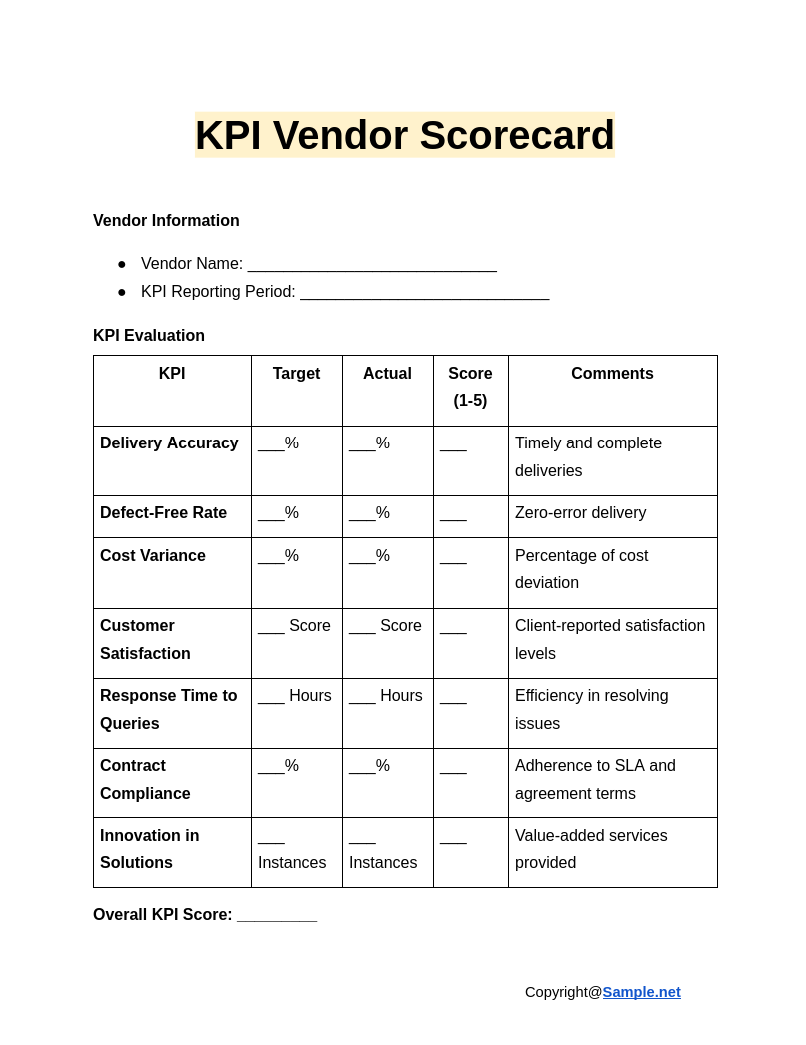
KPI Vendor Scorecard
download now -
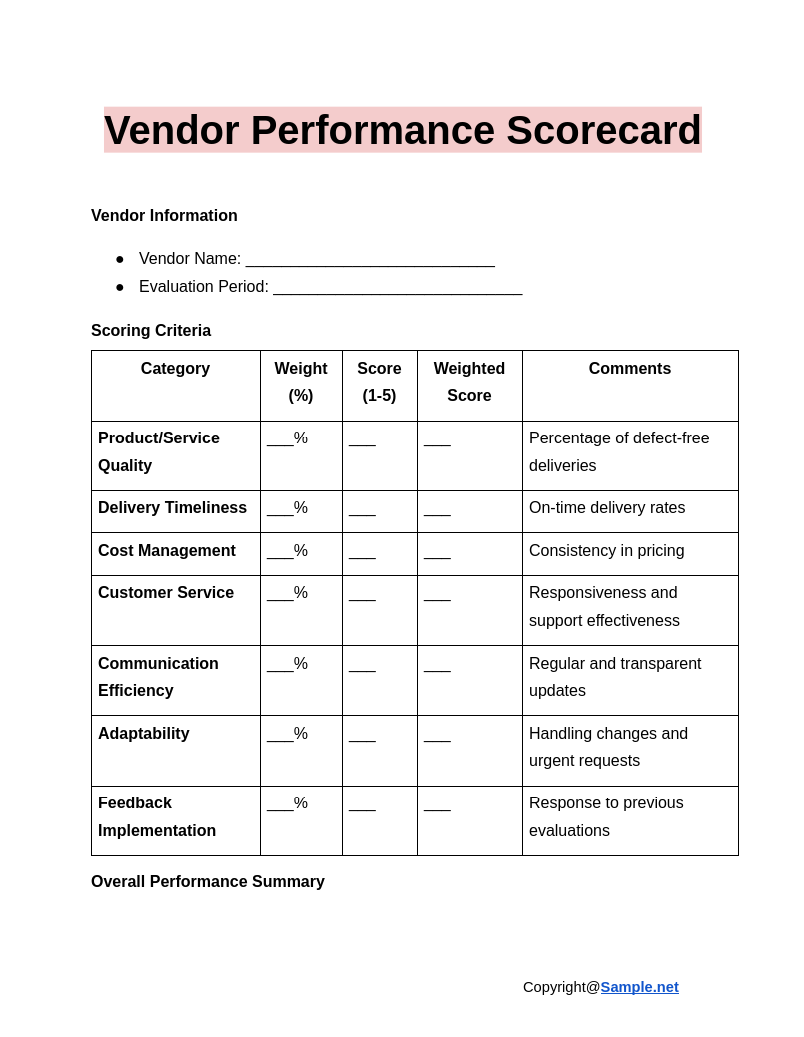
Vendor Performance Scorecard
download now -
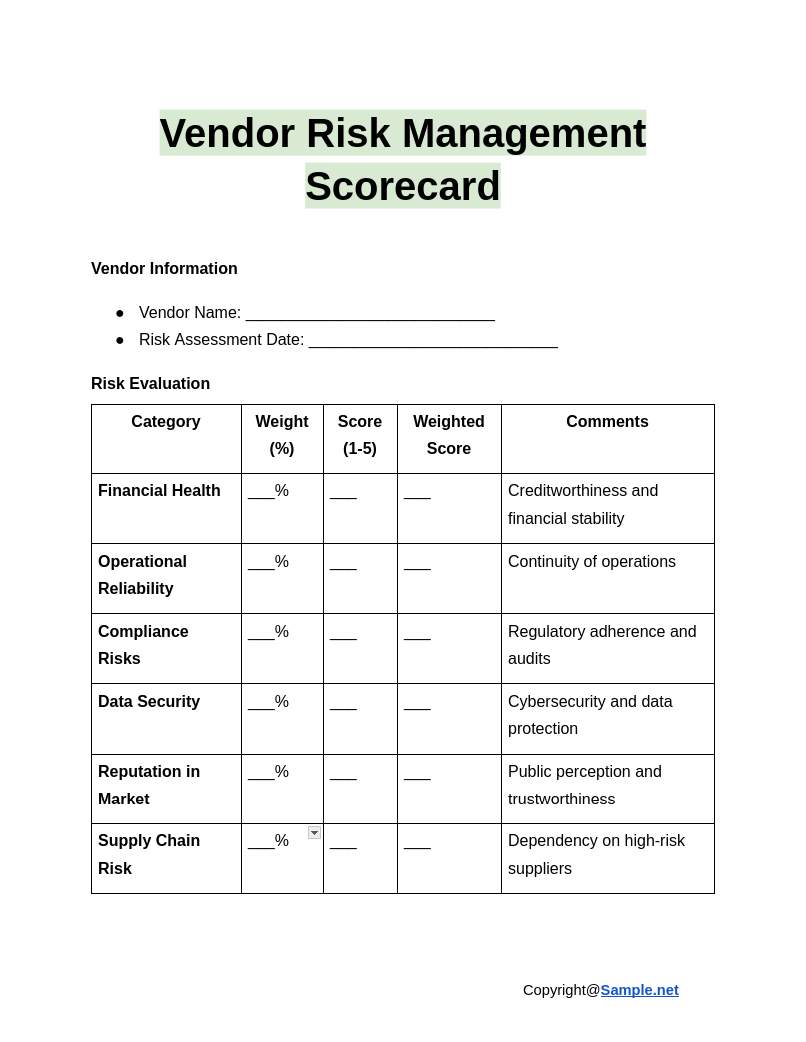
Vendor Risk Management Scorecard
download now -
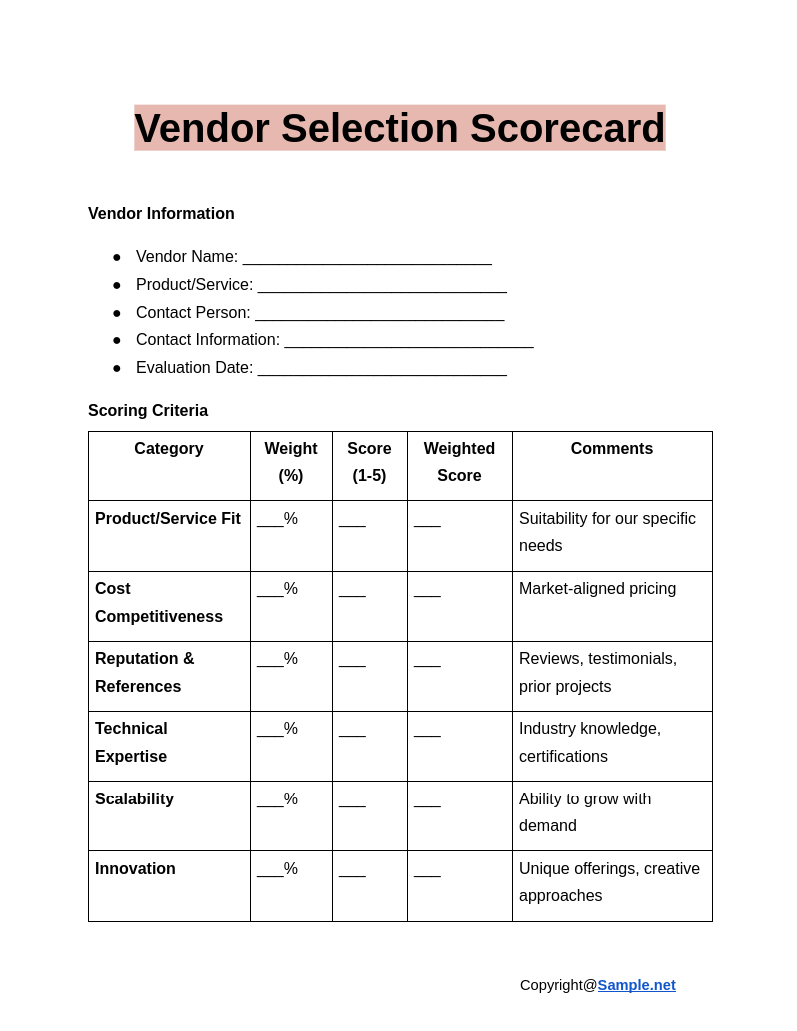
Vendor Selection Scorecard
download now -

Digital Banking Platform Vendor Scorecard
download now -
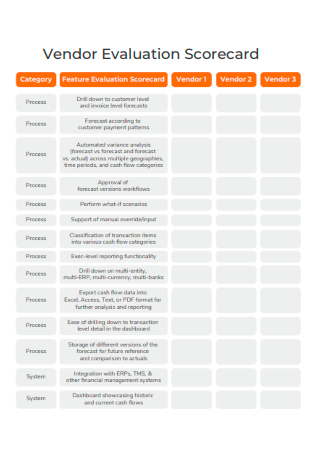
Automation Vendor Evaluation Scorecard
download now -
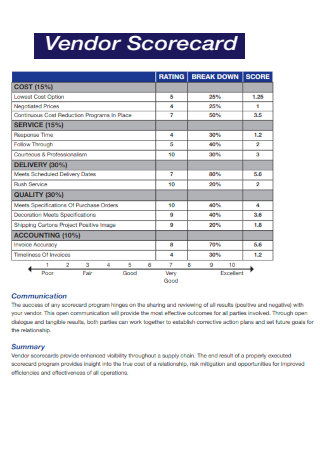
Basic Vendor Scorecard
download now -
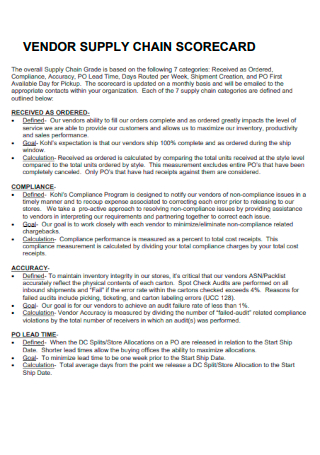
Vendor Supply Chain Scorecard
download now -
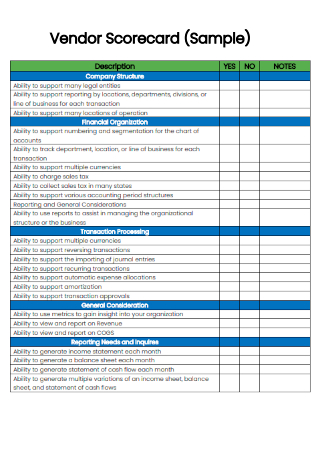
Sample Vendor Scorecard
download now -
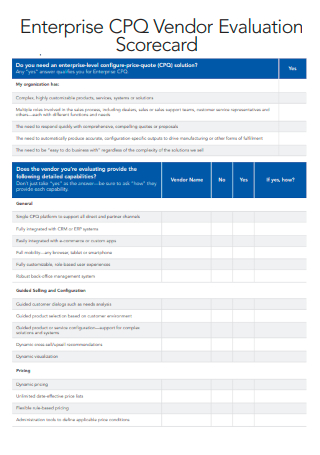
Enterprise CPQ Vendor Evaluation Scorecard
download now -
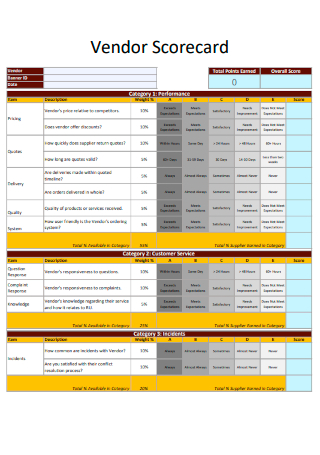
Formal Vendor Scorecard
download now -
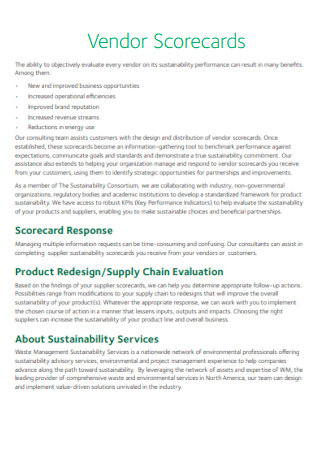
Printable Vendor Scorecard
download now
What is a Vendor Scorecard?
Vendor scorecards are used to manage and evaluate the performance of vendors. They can range from basic to complicated, with as many or as few criteria as are regarded successful in achieving an organization’s goals. Vendor scorecards, when utilized correctly and regularly, enable you to objectively detect and resolve issues, limit expenses, and, ultimately, enhance relationships with Suppliers, particularly those vital to your operations. Vendor scorecards also provide an objective lens for monitoring vendor performance by helping you to establish the most critical vendor performance criteria for you and your suppliers. A vendor scorecard example has been provided for you for additional reference. You can also see more on Vendor Performance Evaluation.
Purposes of a Vendor Scorecard
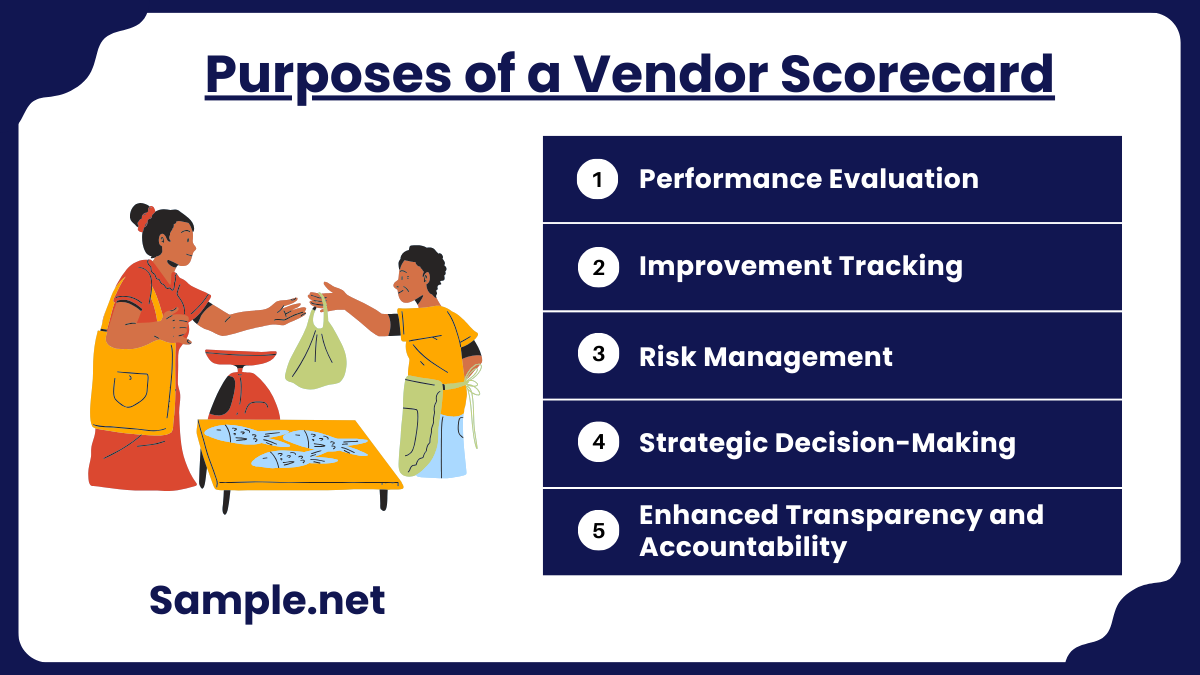
1. Performance Evaluation: A vendor scorecard provides a structured approach to assessing supplier performance over time. This ensures vendors consistently meet quality, cost, and delivery expectations.
2. Improvement Tracking: By identifying gaps in performance, businesses can work collaboratively with vendors to implement improvements, fostering a mutually beneficial relationship. You can also see more on Professional Balanced Scorecards.
3. Risk Management: Regular evaluations help organizations identify underperforming vendors early, mitigating risks such as supply chain disruptions or non-compliance with standards.
4. Strategic Decision-Making: Vendor scorecards offer actionable insights that help in making critical decisions, such as vendor retention, replacement, or contract renewal.
5. Enhanced Transparency and Accountability: By clearly communicating performance metrics and expectations, vendor scorecards encourage accountability, ensuring vendors align with organizational goals.You can also see more on Baseball Scoresheet.
How to Create a Vendor Scorecard
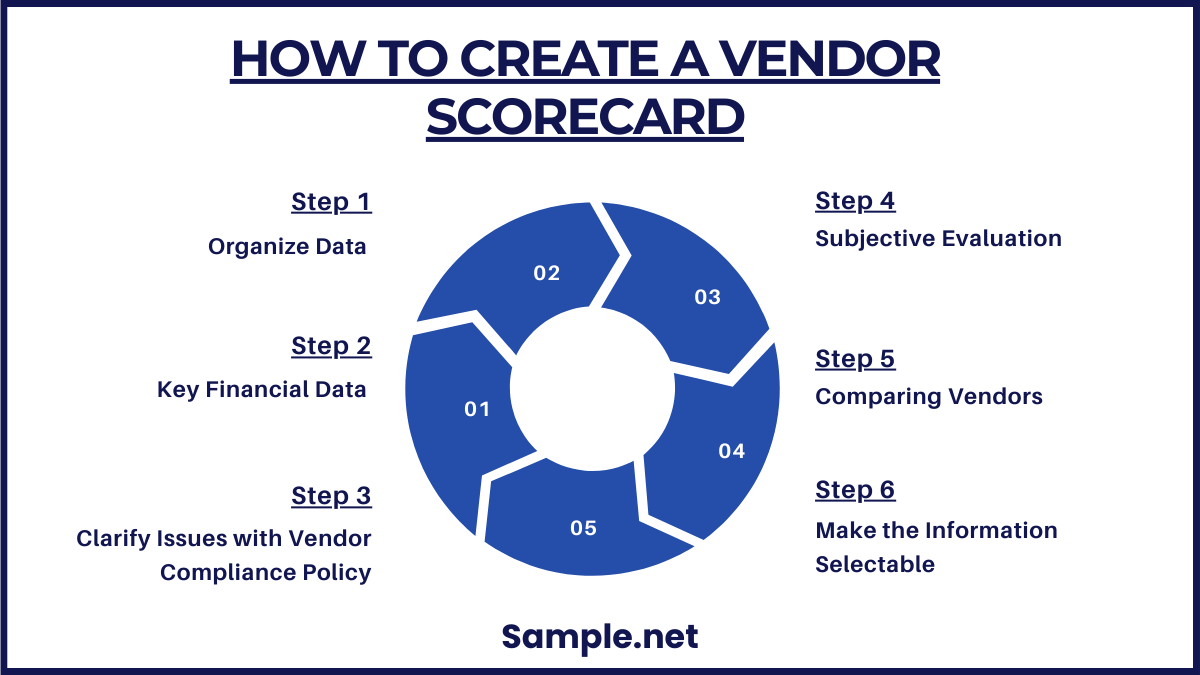
When meeting and negotiating with vendors, most merchants manually extract crucial data from several platforms. A standardized procedure, accessible to other managers through security access, would tremendously help your company. Just as the criteria and reasons have been stated above, you can then proceed to the process of creating a vendor scorecard. To have a polished vendor scorecard dashboard, you can refer to the vendor scorecard format provided down below.
1. Organize Data
The first thing you will need to do is come up with an organizational manner for your Data. You want to be able to gather and show or report data in two ways: by category, by vendor, and by all of the vendor’s goods in the category. The second by vendor category displays all styles or goods purchased from that merchant. You can also see more on Vendor List.
2. Key Financial Data
The most essential financial data from your merchandising systems are gross demand in dollars and units; cancellations in dollars and units; returns in dollars and units; delivered sales in dollars and units; and the gross margin achieved. Except for the reason for returns reporting, the return reason codes may be ascribed to a vendor issue such as poor quality, damaged items, and so on. Also, every week, conserve the back-ordered cash and units for the merchandise. Backorder data is frequently not cumulative; it is merely as of the run date.
3. Clarify Issues with Vendor Compliance Policy
You will smooth out the kinks in the vendor compliance policy in this part, such as merchandising failure to meet product specifications, quality standards, and samples. Federal and state regulations, the PO and delivery data with the purchase order or order management system and the reception history in dollars and units are all collected. Add the number of POs, money, and items delivered on time to the number of late deliveries. Accounting issues or errors in invoices and packing lists; return to the vendor; drop ship paperwork, etc., and chargeback assessments, in addition to operational rework challenges. You can also see more on Vendor Onboarding Checklist.
4. Subjective Evaluation
It is not always possible to restrict vendor performance to data and computations. This part will help you to map out the areas where suppliers thrive and should be included in the vendor scorecard. Consider how you may build exclusives and private label manufacturing if they are beneficial to your Vendor Partnership relationship. You would also be able to evaluate whether or not they proactively share the difficulties they encounter as part of the vendor scorecard. And lastly, consider whether or not the ideas they bring to the table are advantageous for the overall working relationship.
5. Comparing Vendors
A section of the vendor scorecard is allocated for the comparison of vendors and their performances. Create a system-calculated index to assist you in comparing one vendor to another based on important data criteria such as sales, gross margin, and so on. This section will help you to identify whether or not the working relationship is still plausible in the long run. For additional subjective data, enter an A through E rating regularly or upon the use of this vendor scorecard. You can also see more on Vendor Contact Lists.
6. Make the Information Selectable
The information comes from a variety of sources, including your order management system, finance apps, and vendor compliance spreadsheets. Typically, this data is gathered into a data warehouse on a daily or weekly basis. Users should be able to pick vendor performance statistics by date range, logical vendor groupings, or all vendors, drop-ship vendors against warehouse-stocked merchandise, and import versus domestic sources. Your organization has significant data on vendor performance. Make your vendor scorecard comprehensive, and its usefulness for management analysis and cost reduction potential will increase.
FAQs
What is the purpose of a supplier scorecard?
The major objective is to track and manage Vendor Performance. As a result, employing scorecards is a critical component of the vendor assessment process, allowing you to identify the supplier scorecard advantages. Scorecards are an important tool in vendor management. The document’s data helps companies to optimize return on investment while minimizing risk. Tracking vendor performance also improves outcomes by allowing businesses to communicate expectations, ensure buyers and vendors are working toward the same goals, calculate the total acquisition cost of a product or service, and identify any gaps or supply chain risks that can be mitigated preemptively.
How do you measure the performance of a vendor?
Measuring the performance of a vendor is essential to know whether or not the working relationship is still fruitful. And to track KPIs for efficient vendor performance management, you may use a balanced scorecard or a dashboard. Dashboards focus on operational measures and monitoring processes, whereas balanced scorecards stress global corporate objectives connected to KPIs. You can also see more on Vendor Agreement.
What is the purpose of a vendor risk assessment?
A Vendor Risk Assessment illuminates the risks that companies face when they use the products or services of third-party suppliers. When a vendor performs a crucial business operation, obtains sensitive customer data, or engages with customers, risk evaluations are very important. Planning before encountering a risk is important so you can have an idea of what action to do to address the risk with minimal damages to the business, the vendor, and most of all the customer.
What challenges might arise when implementing a vendor scorecard?
Common challenges include resistance from vendors, inaccurate data collection, and poorly defined metrics. Overcoming these challenges requires clear communication, reliable data systems, and involving vendors in the metric selection process to foster acceptance and accuracy.
How does a vendor scorecard align with organizational goals?
Vendor scorecards are designed to reflect the organization’s priorities. For instance, if cost reduction is a goal, cost-efficiency metrics are emphasized. By aligning scorecards with strategic objectives, organizations ensure that vendor performance contributes to overall success. You can also see more on Vendor Partnership Proposal.
How can businesses customize vendor scorecards for specific industries?
Customization involves selecting industry-relevant metrics and benchmarks. For example, in the manufacturing sector, metrics like defect rate and delivery accuracy are critical. For IT services, customer satisfaction and system uptime might take precedence. Tailoring scorecards ensures relevance and maximizes their effectiveness.
